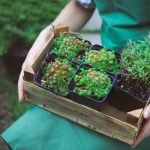Native gardens, filled with plants indigenous to a specific region, are gaining popularity for their beauty and sustainability. In this article, we will explore ideas for native gardens that not only enhance your outdoor space but also support local ecosystems. By incorporating native plants into your garden, you can create a vibrant and thriving landscape while reducing water usage and promoting biodiversity.
Native gardens offer numerous benefits, from providing essential habitats for wildlife to conserving water resources and minimizing the need for chemical inputs. Choosing native plants also helps in maintaining the natural balance of local ecosystems, making them resilient to environmental changes. When selecting plants for your garden, consider factors like soil type, sunlight exposure, and water requirements to ensure their successful growth and sustainability.
Designing a native garden requires thoughtful planning in layout, planting arrangements, and maintenance practices. By carefully selecting a diverse range of native plant species and creating visually appealing landscapes with them, you can attract pollinators, birds, and other beneficial wildlife to your garden. Stay tuned as we delve into must-have native plants for your garden and provide tips on how to overcome common challenges in native gardening.
Benefits of Native Gardens
Native gardens offer a plethora of benefits not only to the environment but also to wildlife and water conservation efforts. By incorporating native plants into your garden, you are essentially creating a natural habitat for local fauna and flora to thrive. These plants have evolved over time to adapt to the local climate, soil, and other environmental conditions, making them more resilient and requiring less maintenance compared to non-native species.
Environmental Benefits
One of the key environmental benefits of native gardens is their ability to support biodiversity. By planting native species, you are providing food and shelter for a variety of insects, birds, and other wildlife that play essential roles in the ecosystem. Additionally, native plants also help improve air quality by absorbing carbon dioxide and releasing oxygen through photosynthesis. They can also help reduce soil erosion and filter pollutants from runoff water.
Wildlife Conservation
Native gardens act as crucial habitats for local wildlife, including pollinators like bees and butterflies. These pollinators play a vital role in plant reproduction and ecosystem health. By creating a garden filled with native plants that attract pollinators, you are contributing to the conservation of these important species. Furthermore, native plants often produce seeds or fruits that serve as food sources for birds, mammals, and insects, further enhancing biodiversity in your garden.
Water Conservation
Incorporating native plants into your garden can also contribute to water conservation efforts. Since native plants are well-suited to the local climate and soil conditions, they require less watering once established compared to non-native species. This not only helps conserve water but also reduces maintenance costs associated with irrigation systems.
Additionally, by reducing the need for excessive watering, you can help prevent water waste and runoff that may carry pollutants into natural waterways. By choosing native plants for your garden, you are not only creating a sustainable landscape but also actively contributing to important environmental and conservation efforts.
Choosing the Right Native Plants
Climate and Location
One of the most important factors to consider when choosing native plants for your garden is the climate and location of your garden. Different native plant species thrive in specific climate zones, so it’s essential to research which plants are best suited for your region’s temperature, sunlight, and soil conditions. By choosing plants that are native to your area, you can create a resilient and low-maintenance garden that will flourish year after year.
Soil Type
Another crucial factor to consider when selecting native plants is the soil type in your garden. Some native plant species prefer well-drained sandy soils, while others thrive in clay or loamy soils. Before planting, test your soil’s pH levels and composition to determine which native plants will be best suited for your garden’s soil type. Amending the soil with organic matter can also help improve its quality and provide a healthy growing environment for your chosen plants.
Water Requirements
It’s important to choose native plants that have similar water requirements to reduce the need for irrigation and conserve water resources. Consider the natural rainfall patterns in your area and select drought-tolerant native plant species that can thrive with minimal watering once established. By incorporating water-wise native plants into your garden, you can create a sustainable landscape that supports local ecosystems and reduces water consumption.
Designing Your Native Garden
When it comes to designing a native garden, there are several key factors to keep in mind to ensure the success of your landscaping project. One important tip is to consider the layout of your garden. Think about the natural growth patterns of the plants you choose and how they will interact with each other once they are fully mature. This can help you create a harmonious and sustainable ecosystem within your garden space.
In terms of planting, it is essential to select native plants that are well-suited to your specific climate and soil conditions. Researching indigenous plant species in your area can provide insight into which plants will thrive in your garden without the need for excessive watering or fertilization. Additionally, grouping plants with similar water and sunlight requirements together can make maintenance easier while promoting healthy growth.
Maintenance is an ongoing task when it comes to native gardens, but there are ways to minimize the effort involved. Regular weeding, pruning, and mulching can help keep your garden looking tidy and support plant health.
Using organic materials for mulch, such as shredded leaves or bark chips, can also contribute to soil health and water retention. By staying attentive to the needs of your native plants and addressing any issues promptly, you can enjoy a beautiful and vibrant garden year-round.
| Aspect | Tips |
|---|---|
| Layout | Consider natural growth patterns; Create harmonious ecosystem |
| Planting | Select native plants suited to climate; Group by water/sunlight needs |
| Maintenance | Weed, prune, mulch regularly; Use organic materials for soil health |
10 Must-Have Native Plants for Your Garden
Native gardens are becoming increasingly popular due to their numerous benefits for the environment, wildlife, and water conservation. When it comes to choosing the right native plants for your garden, there are several factors to consider.
One key factor is selecting plants that are native to your specific region or climate, as these will thrive in their natural habitat and require less maintenance. Additionally, consider the sunlight and soil conditions in your garden to ensure that the chosen plants will flourish.
Incorporating a variety of native plants in your garden not only adds visual interest but also supports local ecosystems. Some must-have native plants for your garden may include milkweed, which attracts butterflies and other pollinators, or coneflowers, which provide food and shelter for birds. Other popular choices are purple coneflower, goldenrod, and butterfly weed. These plants not only enhance the beauty of your garden but also contribute to the overall health of the ecosystem.
| Plant Name | Main Features |
|---|---|
| Milkweed (Asclepias) | Attracts butterflies and other pollinators |
| Coneflowers (Echinacea) | Provides food and shelter for birds |
| Purple Coneflower (Echinacea purpurea) | Drought-tolerant perennial with striking purple flowers |
By incorporating these must-have native plants into your garden design, you can create a beautiful and sustainable landscape that benefits both local wildlife and the environment. Remember to research additional native plant species that are suitable for your specific region to further enhance the biodiversity of your garden.
Native Garden Landscaping
When it comes to landscaping with native plants, there are endless possibilities to create visual appeal in your garden. By carefully selecting and arranging these plants, you can achieve a natural and harmonious look that enhances the beauty of your outdoor space. Here are some ideas for native gardens landscaping:
- Consider the natural habitat: Before selecting plants for your native garden, think about the natural environment they thrive in. This will ensure that they are well-suited to the conditions of your garden and will require less maintenance.
- Create layers: To add depth and interest to your garden, incorporate plants of varying heights and textures. Tall trees, shrubs, ground covers, and flowering perennials can be strategically placed to create a visually dynamic landscape.
- Use color effectively: Play with different colors to make your native garden visually appealing throughout the year. Choose plants that bloom at different times to ensure continuous color in your garden.
Incorporating native grasses into your landscape design can also add texture and movement to your garden. Grasses like switchgrass, little bluestem, and muhly grass provide structure, form, and visual interest while requiring minimal maintenance. Additionally, incorporating rocks, gravel pathways, or water features can further enhance the aesthetics of your native garden.
By creating focal points within your landscape design-a striking tree, a cluster of colorful flowers or a unique plant species-you can draw attention to specific areas of your garden and create visual interest. Whether you opt for a formal layout or a more naturalistic design, incorporating these ideas for native gardens landscaping will help you create a visually appealing and sustainable outdoor space that supports local biodiversity.
Remember that the key to successful native garden landscaping lies in careful planning and thoughtful plant selection. By incorporating these ideas into your design process, you can create a beautiful and thriving native garden that not only enhances the aesthetics of your outdoor space but also contributes positively to the environment by supporting local wildlife and conserving water resources.
Overcoming Common Challenges in Native Gardening
Native gardens are not without their challenges, but with the right strategies in place, you can overcome common obstacles like pest control, watering, and soil issues. Here are some tips to help your native garden thrive:
- Pest Control:
- Watering:
- Soil Issues:
One of the biggest challenges in maintaining a native garden is dealing with pests that may damage or destroy your plants. To address this issue without resorting to harmful chemicals, consider introducing natural predators like ladybugs or lacewings to keep pest populations in check. You can also plant companion plants that repel pests or create barriers using organic solutions like neem oil.
Proper watering is essential for the health of your native plants, especially during the establishment phase. To minimize water usage and prevent overwatering, choose drought-tolerant native species that are well-suited to your region’s climate. Implement efficient irrigation methods such as drip systems or soaker hoses to deliver water directly to the roots while reducing evaporation.
The quality of your soil plays a crucial role in the success of your native garden. Conduct a soil test to determine its pH level and nutrient content, then amend it as needed with organic matter like compost or mulch. For areas with poor drainage, consider adding raised beds or incorporating native plants that thrive in wet conditions.
By proactively addressing these common challenges, you can ensure that your native garden not only survives but thrives with minimal intervention. Remember to monitor your garden regularly, adjust your maintenance practices as necessary, and seek advice from local gardening experts if you encounter any specific issues related to pest control, watering, or soil quality. With patience and persistence, you can enjoy a vibrant and sustainable landscape filled with beautiful native plants.
Native Garden Inspiration
Native gardens are not only beneficial for the environment and wildlife but can also offer a stunning visual appeal to your outdoor space. When it comes to creating a native garden, one of the key factors to consider is the climate in which you live. Different climates require different types of native plants that thrive in specific conditions, ensuring the success and sustainability of your garden.
For those living in dry, arid climates, consider incorporating drought-tolerant native plants such as desert marigold, agave, or penstemon. These plants are well-adapted to survive with minimal water and can add a pop of color to your garden even in harsh conditions. In contrast, if you reside in a more temperate climate, opt for native ferns, wildflowers like coneflowers or black-eyed susans, and shrubs such as hydrangeas for a lush and diverse garden landscape.
When designing your native garden, take into account the natural topography of your yard and consider creating different levels or zones within the space to mimic the diversity found in nature. Incorporating elements like rock formations, small ponds or birdbaths can attract wildlife and provide a focal point for your garden design. Don’t be afraid to mix textures, colors, and heights of native plants to create visual interest and a dynamic outdoor space that reflects the beauty of nature.
Looking for inspiration? Explore local botanical gardens, visit native plant nurseries, or attend gardening expos in your area to discover unique ideas for native gardens that suit your specific climate and aesthetic preferences. By showcasing stunning examples of successful native garden designs, you can gather ideas on layout, plant combinations, and maintenance practices that will help you create a beautiful and sustainable outdoor oasis right in your own backyard.
Conclusion
In conclusion, the allure of native gardens lies in their blend of beauty and sustainability. By choosing to incorporate native plants into your garden, you not only enhance the aesthetic appeal but also contribute to the preservation of local ecosystems. The benefits of native gardens go beyond just visual aesthetics; they also play a vital role in supporting wildlife, conserving water, and promoting environmental health.
When embarking on your journey to create a native garden, remember to consider various factors such as soil types, sunlight levels, and water requirements when selecting the right plants. By carefully planning the layout and design of your garden, you can ensure that it thrives with minimal maintenance while still attracting pollinators and other beneficial insects.
As you explore different ideas for native gardens showcased in stunning designs across diverse climates, take inspiration from how these spaces seamlessly integrate with their surroundings. By overcoming common challenges such as pest control or soil issues with eco-friendly solutions, you can cultivate a vibrant and sustainable oasis right in your own backyard.
Embrace the beauty and sustainability of native gardens and let your creativity flourish as you create a thriving ecosystem that supports both nature and your well-being.
Frequently Asked Questions
How Do I Make My Native Garden Look Nice?
To make your native garden look nice, consider incorporating a variety of native plants that bloom at different times of the year to ensure continuous color and interest. Adding paths, seating areas, and artistic elements can also enhance the overall aesthetic of your garden.
Can You Mix Native Plants With Other Plants?
Yes, you can mix native plants with other plants in your garden. However, it is important to choose companion plants that have similar growing conditions to ensure they thrive together. Be mindful of invasive species and choose non-invasive plants to avoid ecological issues.
How to Make a Sacred Garden?
Creating a sacred garden involves selecting meaningful plants, such as those with spiritual significance or traditional uses. Incorporating elements like a meditation area, water feature, or labyrinth can help cultivate a sense of peace and connection with nature in the space.

Welcome to my gardening blog! I am passionate about plants and enjoy sharing my knowledge and experiences with others. In this blog, I will write about everything related to gardening, from tips on how to get started to updates on my own garden projects.





